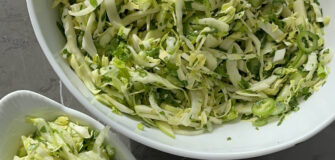10 Festive Foods for Rosh Hashanah

Rosh Hashanah, the start of a beautiful new year. This Jewish celebration, like all Jewish celebrations, is steeped in tradition, with foods that symbolize our hopes and dreams for the coming months. As the Book of Life opens, many Jewish families commemorate the holiday by gathering with family and friends. And when we gather, we eat!
Beyond apples dipped in honey (which you probably know about already), we’ve outlined 10 foods you can bring in to your new year soiree to make it sweet, festive, tasty, and maybe a little exotic. Welcome to 5783!

Challah
No surprise to find everyone’s favorite bread on the table, but with *a twist* at the new year. For the holiday, the dough is typically shaped and baked in spirals or rounds. While we cannot be certain of the original intent of the tradition, there are two that are common. The first is that the round shape symbolizes continuity, or the circular nature of the year and its seasons. The other is a little more regal: it is often thought that the challah was shaped to look like a crown, as in the crown of God when we coronate him as the king of the world. Either way, it tastes incredible!

New Fruit / Pomegranate
“New fruit” refers to fruit that has not been eaten in a long time because it was out of season, as in the pomegranate. Harvested in early fall, many of the Jewish faith save their first taste of the pomegranate for the high holy days (or their only taste, depending on how one feels about pomegranates).
According to tradition, this fruit is one of the “seven species of Israel” and is a symbol of many things: righteousness, abundance, wisdom, fertility, and knowledge. All good things to aspire to in a new year! The pomegranate is also said to have exactly 613 seeds, with each one representing one of the 613 mitzvot of the Torah.

Carrots
While the words ‘carrot’ and ‘decree’ don’t sound very much alike at all in English, the same can’t be said of their Hebrew counterparts. The word for carrot is gezer, and it is similar to gzeira, the word for decree. Because of these Hebrew homophones, Jewish tradition has us eating carrots for the new year in hope that God would nullify any evil decrees, or official orders, against us.
Carrots further align with the holiday because they are among the sweetest vegetables, packing more sugar pound for pound than most other root vegetables. They are versatile and can be prepared in any number of ways – eat them fresh, roast them, include them in a stew, and more.

Couscous with Seven Vegetables
As the biblical world was created in seven days, seven is a lucky number in Judaism. Couscous with seven vegetables is a dish enjoyed by Jews in Morocco and other North African nations. For the vegetables, you’ll often find (more) carrots, cabbage, pumpkin, onion, turnips, zucchini, and chickpeas but there’s no hard and fast rule. It’s also well-seasoned, but not too spicy.
The many tiny grains of the couscous are thought to represent our hopes that new year will include countless blessings.

Fish
Fish, prepared in any one of a number of ways, is often on the Jewish New Year menu. There is an accompanying prayer in Hebrew, which translates to “May it be God’s will that we be fruitful and multiply like fish.” Therefore, the fish expresses our desire for blessings in the year ahead.
Head on? The literal meaning of Rosh Hashanah is “head of the year.” A fish is often served with the head on and a blessing which means “May we be heads, not tails.” This is commonly interpreted as an intention to be a leader rather than a follower.

Beets
More fun with words. Beets and even spinach and chard, are commonly prepared for festive meals because of the symbolism associated with their traditional names. Selek is the Hebrew word for beets, and it sounds quite like the Hebrew word for remove. Beets are chosen in hopes that our enemies will be removed, leaving us in peace.

Keftes de Prasa
Keftes de Prasa are truly a tasty Sephardic treat. They are fried leek pancakes made with eggs and bread crumbs. They have become a traditional Rosh Hashanah food specifically because of the start ingredient: the leek. The Aramic word for leeks from ancient times sounds like the Aramic word for destroy, or cut off. This is another food chosen for its hopeful meaning – that our enemies are cut off from us, so they cannot hurt us.
The Keftes de Prasa are also known as yehi rasones or yehi ratsones in Hebrew, which translates to “May it be your will.” For info on how to make Keftes de Prasa check out Oz Telem’s food blog at oztelem. com.

Tzimmes
Tzimmes is Yiddish for “a big fuss’. In that case, this is an aptly named dish because it involves a good deal of slicing, dicing, and stirring. Tzimmes is a traditional side dish made of carrots and other root vegetables, along with dried fruit like raisins or prunes, and often sweetened with honey.
Like the sweet stuff we discussed earlier, tzimmes represents our wish for a sweet new year. With the bonus benefit of the carrots’ deterrence of evil decrees, this is a two-for-one.

Dates
Like the pomegranate, dates are one of the seven species of Israel and are even referenced in the Babylonian Talmud as a part of the holiday celebrations. It is commonly believed that the dates are present at the Rosh Hashanah table much like carrots are, because of their Hebrew name, t’marim. The word’s root is connected another word, tam, which means ‘ceased to exist’ or “finished.” Tradition holds that we eat dates to ask God to finish off our enemies, so to speak.
Also like the carrot, they happen to be very sweet: when Israel was called “a land flowing with milk and honey,” it was actually date honey that was doing the flowing.

Honey Cake or Tishpishti
You may be full by now from this feast loaded with delicious flavors and deeper meanings, but hopefully there’s still room for dessert. A traditional honey cake should do nicely, one last wish for sweetness as the Book of Life opens.
For some variety, try another Sephardic recipe for tishpishti, a gluten-free nut-based cake infused with sugary syrup and walnuts. It’s the perfect way to end your meal with an exotic flair that is sure to delight all the people around you as you wish each other “Shanah tovah!”



































